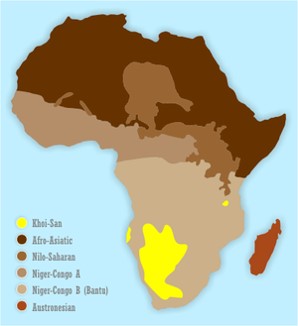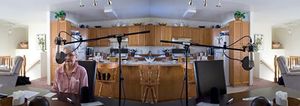Course:FNEL 380/The Languages of Photography & Sound
Traditionally, language and language preservation encompasses only the sounds of the language themselves. This is noted in recordings and documents for language preservation, where the main, and often only, purpose is to retain the language and have it accessible for later generation. John Wynne challenges this view by incorporating photographs and external sounds or manipulated audio into his art installations to give life to his recordings of Botswana's Khoi and San speakers and Gitxsan people of the Northwest Coast. His exhibits provide faces to the faceless and show the fragility of these languages. His recordings are unscripted and are meant to be conversational interpretations and representations of language and culture[1].

John Wynne
John Wynne is a sound and visual artist, born in Germany in 1957 and now works in the UK. He grew up in Canada and gained some attachment to the country that would later influence some of his language endangerment exhibits[2]. He has many famous and successful art installations, through two stand out as important to the concept of language endangerment in small and marginalized indigenous communities of Canada and Botswana[3].
Hearing Voices

Hearing Voices was Wynne's first experience with language endangerment. Wynne discusses his first encounters with language endangerment and preservation of endangered languages in Botswana, where the San and Khoi groups (as named by academics) speak two distinct, mutually unintelligible clicking languages that are grammatically and structurally complex[4]. The speakers of Khoi and San never had a tradition of naming their groups or communities like it seen in indigenous groups elsewhere, and Khoi and San are considered the less offensive of the original English names given to them by early colonialists that called them barbaric and their language as gagging and clucking sounds.


These recordings are powerful pieces of political and social statements that bring together stories, lore, history, lifestyle, and current events happening within the community[5]. Currently, the groups are under forced migration from the government off their traditional lands they have occupied for 1000s of years, and their lifestyles have been completely altered with little to no access of traditional hunting and gathering resources, and a more heavy reliance on government handouts.
Hearing Voices was the installation that came with these recordings. In the exhibit, Wynne uses the recordings of the people along with photographs of them during their recordings to represent that ethnographic lens and clear presence Wynne had during these recordings, as well as giving faces to those who have been silenced or previously ignored on a sociopolitical scale[6]. The recordings were also edited in order to emphasize, elongate, and slow down the sounds and voices of the speakers as well[7]. When this project was complete, Wynne spent time ensuring access was made available to speakers and their families and community as well as the public. As demonstrated with the website and app, it was something meant to be retained for a long time and used by people long after the installation was finished[8].
Anspayaxw

The Anspayaxw is a small reserve in BC, also known as Kispoix, where Wynne worked with the Gitxsan community. Wynne's exhibit, named after the reserve. incorporates the voices of the people, recorded in both English and Gixsanimaax, as well as the sounds of the world around them to accompany the imperfectly mirrored photographs as a representation of language and language loss, and the both modern and historic silencing of indigenous languages and voices[9]. Other images and photos were taken from around the community, showing road signs written in Gitxsanimaax and the influence of the ecological and social world on the community[10].


Wynne grew up Canada and turned his focus to the Northwest coast, where there were a significant number of indigenous languages on the verge of extinction. He went to UBC, where he got in touch with Tyler Peterson, a linguist already working with the Gixsanimaax language[11]. Tsimshian, the language family Gixsanimaax is related to, is an isolated family with no known roots outside of a small geographic area. This language includes a lot of breathy sounds and voiceless fricatives that were difficult, at times, to capture on a sound recording. Wynne decided to match these sounds with the natural, ecological sounds from the environment surrounding the reserve, aiming to create an immersive sounds environment, where the sounds of nature influenced and inspired the sounds of the language[12]. The voices of the speakers are unedited, but the sounds overlap each other throughout the exhibition[13]. Through this, Wynne’s goal was to start conversations between community members, academics, and artists[14].
Thelma Blackstock

Thelma Blackstock is one of the Gitxsan speakers Wynne recorded for his Anspayaxw exhibit. In the exhibit, she speaks a funeral song, Breath (in English) originally for the sake of later translation and transcribing. The song was recorded with the permission of the Geel of the community at the time, who has since passed away. Now, Wynne asks the current Geel for permission to use the song in the exhibit each time it is reconstructed. In the recording, Thelma stops partway through to explain that it is difficult to speak words that are traditionally sung, which Wynne included in the exhibit as a way of showing the ethnographic barrier and what can be lost while doing linguistic research of endangered languages[15].
Linguistic and Social Commonalities
As mentioned, his work with the Khoi and San languages was Wynne’s first experience with endangered languages. With this understanding, he specifically chose the Northwest Coast as his next project because of the linguistic diversity and high level of endangerment[16]. He found that both of these projects worked with languages unique to their own cultures and confined into a small geographic area – Southern Africa is the only location (with one known exception from an extinct Australian language) that has communities that utilize clicks in their speech. Gixsanimaax a daughter language of the Tsimshian family, which is isolated into a very small region of BC[17]. During his time recording, Wynne found unique linguistic patterns and attributes he built upon and edited for the installations, such as emphasizing the complex system of vowels in Hearing Voices, and the breathless qualities of Gixsanimaax overlaid with the sounds of nature.
Though both projects are strikingly similar in their components and intentions, Wynne made sure to talker his work based specifically on the experiences of the people and the how the sounds of their voices resonated once recorded – the breathy tones made the Gitxsan people made it near impossible to replicate the voice manipulation techniques he used with the clicking languages without losing the sounds themselves in the editing process[18]. I believe an important thing to take away from John Wynne’s work is the fact that this is a global phenomenon that is happening in extremely diverse locations at alarming rates. Despite the thousands of kilometers between Botswana and BC, the Khoi and San speakers share so many struggles with the Gitxsan people.
References
- ↑ Hearing Voices: Research and creative practice across cultures and disciplines
- ↑ http://www.saatchigallery.com/artists/john_wynne.htm
- ↑ Hearing Voices: Research and creative practice across cultures and disciplines
- ↑ Hearing Voices: Research and creative practice across cultures and disciplines
- ↑ Hearing Voices: Research and creative practice across cultures and disciplines
- ↑ Hearing Voices: Research and creative practice across cultures and disciplines
- ↑ Hearing Voices: Research and creative practice across cultures and disciplines
- ↑ Hearing Voices: Research and creative practice across cultures and disciplines
- ↑ Asymmetrical Translations: John Wynne’s Anspayaxw
- ↑ Asymmetrical Translations: John Wynne’s Anspayaxw
- ↑ Hearing Voices: Research and creative practice across cultures and disciplines
- ↑ Hearing Voices: Research and creative practice across cultures and disciplines
- ↑ Asymmetrical Translations: John Wynne’s Anspayaxw
- ↑ Asymmetrical Translations: John Wynne’s Anspayaxw
- ↑ Hearing Voices: Research and creative practice across cultures and disciplines
- ↑ Hearing Voices: Research and creative practice across cultures and disciplines
- ↑ Hearing Voices: Research and creative practice across cultures and disciplines
- ↑ Hearing Voices: Research and creative practice across cultures and disciplines